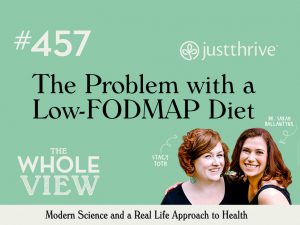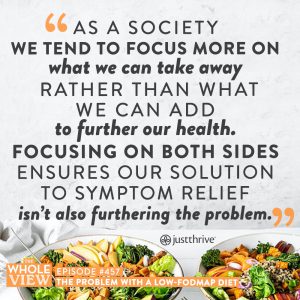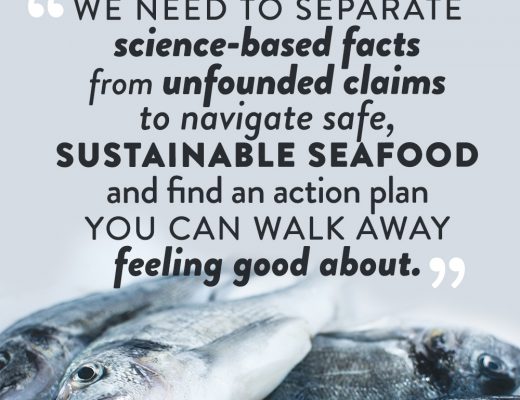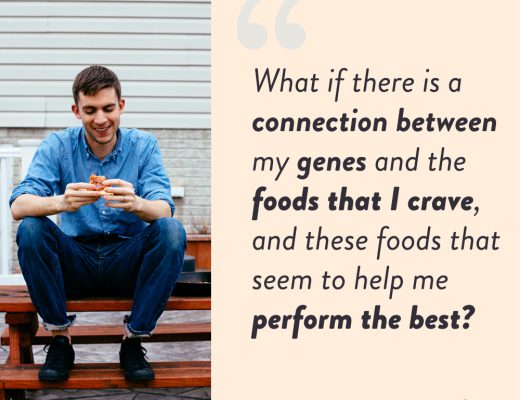
Welcome to episode 457 of The Whole View! This week, Sarah and Stacy revisit the science and examine the problem with a Low-FODMAP Diet. Sarah breaks down the science on what a FODMAP is, how they impact the gut microbiome, and it can cause the problem with a low-FODMAP diet.
If you enjoy the show, please review it on iTunes!
The Whole View, Episode 457: The Problem with a Low-FODMAP Diet
Welcome back to episode 457! (0:28)
Sarah and Stacy last covered FODMAPs in detail in TPV Podcast Episode 238, What’s a FODMAP and Why Do Some People Avoid Them?
The science on them has definitely evolved, so it’s time to revisit what FODMAPs are and why there can be a problem with a low-FODMAP diet!
This show is sponsored by Stacy and Sarah’s favorite probiotic company, Just Thrive!
Formulated by microbiologists, Just Thrive Probiotic includes four science-backed, clinically proven, super-beneficial Bacillus species. It is free of wheat, gluten, Dairy, nuts, soy, salt, sugar, artificial colors or flavors, binders, fillers, allergens, and GMO’s.
Stacy and Sarah only invite brands they love to be a part of this show and never endorse something they don’t use themselves.
Just Thrive is offering 15% off with code THEWHOLEVIEW at checkout, or follow this link!
Quick Review of FODMAPs
The term FODMAP is an acronym for Fermentable Oligosaccharides, Monosaccharides, Disaccharides, and Polyols. (4:10)
FODMAPs are sugar alcohols and short-chain carbohydrates rich in fructose molecules.
These molecules are inefficiently absorbed in the small intestine but are highly fermentable by our gut bacteria in the large intestine.
Many dietary carbohydrates that have prebiotic actions are members of the FODMAP group of carbohydrates: Fructo-oligosaccharides (FOS), galactooligosaccharides (GOS), xylooligosaccharides (XOS), polyols, and fructose.
These FODMAPs selectively stimulate the growth of super beneficial specific types of bacteria. They include Bifidobacteria, Lactobacillus, Akkermansia municiphila, Faecalibacterium prausnitzii, Roseburia intestinalis, Eubacterium rectale, and Anaerostipes caccae.
When FODMAPs enter the large intestine full of those wonderful beneficial bacteria, they increase the metabolic activity of our gut bacteria. This increases the production of SCFAs and gasses.
Because of the increase in production, we might notice even if we eat a ton of FODMAPs all at once is an increase in flatus frequency. Sarah adds that this is perfectly normal.
FODMAP Intolerance
Where it flips into FODMAP intolerance is when it becomes uncomfortable. (10:34)
Typical symptoms of FODMAPs include bloating, gas, cramps, diarrhea, constipation, indigestion, and sometimes excessive belching.
This is why a typical diagnosis is Irritable Bowel Syndrome. Some researchers even believe that 100% of IBS is caused by FODMAP intolerance.
So, what causes FODMAP intolerance? There’s three potentially overlapping, causes
- Gluten and/or Dairy sensitivity
- Fructose malabsorption
- Gut dysbiosis
Gluten Sensitivity
The biggest source of FODMAPs in the Standard American Diet is wheat.
This is because wheat is consumed in large quantities, not because it is a concentrated source of FODMAPs.
Additionally, up to 55% of the population (in North America) has gluten sensitivity genes!
Symptoms of non-celiac gluten sensitivity include IBS bloating, gas, cramps, diarrhea, constipation, indigestion, and belching.
PLUS extra-intestinal symptoms, such as brain fog, fatigue, lethargy, skin rash (including eczema), headaches, fibromyalgia-like symptoms (joint and/or muscle pain), carpal tunnel and peripheral neuropathy-like symptoms, depression, anxiety, and anemia
2012 double-blind elimination and challenge study showed 30% of IBS was wheat sensitivity.
Stacy and Sarah discussed these genes in detail in TPV Podcast, Episode 293: Do I Have to Be Gluten-Free Forever?
Dairy Sensitivity
And lactose is a FODMAP! Lactose intolerance is caused a deficiency in the enzyme lactase.
Rates of intolerance vary widely based on ethnicity, ranging from 5% among Northern Europeans to over 90% of the population in some Asian and African countries.
In fact, in the US alone, somewhere between 30 and 50 million people are lactose intolerant!
Also, epidemiological reports of cow’s milk allergy (IgE antibody reactions to cow’s milk proteins) range from between 1 and 17.5% in preschoolers, 1 and 13.5% in children ages 5 to 16 years, and 1 to 4% in adults.
The prevalence of cow’s milk sensitivities (IgA and IgG antibody reactions to cow’s milk proteins) in the general population is unknown.
But one study in patients with Irritable Bowel Syndrome showed that a whopping 84% of participants tested positive for IgG antibodies against milk proteins.
Other Food Sensitivities
Soy is also a high-FODMAP food. The rate of soy IgG intolerance in IBS is about 23%.
IBS is strongly linked to food sensitivity. And up to 65% of people have symptoms resolved if they do IgG testing and eliminate all the positives.
Some people eliminate FODMAPs, and their symptoms go away. So they think it’s FODMAP intolerance, but it’s really gluten, Dairy, soy, or other sensitivity.
So, they’re eliminating a ton of healthy fruits and veggies needlessly! Sarah and Stacy will get into why that’s important.
Fructose Malabsorption
After digestion, monosaccharides are absorbed into the bloodstream by being transported through the cells that line the small intestine, the enterocytes. (20:54)
Enterocytes have specialized transporters, or carriers, embedded into the membrane that faces the inside of the gut.
FODMAP intolerance may be due to insufficient carbohydrate carriers, specifically GLUT5, which is the specific carbohydrate carrier for fructose. This can happen, for example, in celiac disease, where you have intestinal villous atrophy.
Fructose uptake rate by GLUT5 is also significantly affected by diabetes mellitus, hypertension, obesity, and inflammation. This uptake rate is also influenced by diet!
The simultaneous presence of glucose can inhibit uptake, which is why whole fruit might be tolerated where something like agave might not. Additionally, the simultaneous presence of sorbitol can inhibit this.
It’s important to note that while fructose malabsorption causes symptoms extremely similar to IBS, it’s considered a separate diagnosis.
However, due to the similarity in symptoms, patients with fructose malabsorption often fit the profile of those with irritable bowel syndrome.
Stacy adds that she and Sarah are not medical professionals. If you are struggling with symptoms like those listed, it’s best to arm yourself with this knowledge and seek trained professionals to help narrow down your diagnosis.
Gut Dysbiosis
The most likely cause of symptoms is actually Gut Dysbiosis.
If there’s an imbalanced gut microbiome, such as the right species for cross-feeding (or a high consumption of FODMAPs all at once), this causes a variety of digestive symptoms,
For example, it has been shown that consuming fructans increases the production of butyrate. But the two main types of bacteria that ferment fructans (Bifidobacteria and Lactobacilli) are lactic acid-producing bacteria.
Many other bacteria (including Eubacterium, Roseburia, and Faecalibacterium) account for this bump in butyrate production.
Acetate serves as an essential co-factor and metabolite for key bacteria like Faecalibacterium prausnitzii, which requires acetate to grow.
The Most Likely Culprit
Studies confirmed that gut dysbiosis is the most likely culprit in IBS.
This study compared participants with IBS to healthy controls.
Another study detected dysbiosis in 73% of IBS patients vs. 16% of healthy individuals.
This basically captures all the people with IBS symptoms that don’t have food sensitivities (with some overlap)
And studies confirm more gas production from FODMAP consumption in people with IBS.
This study aimed to compare the patterns of breath hydrogen and methane and symptoms produced in response to diets that differed only in FODMAP content. They concluded dietary FODMAPs induce prolonged hydrogen production in the intestine that is greater in IBS.
Sarah has taken part in several different breath tests in her lifetime and always finds them interesting.
The problem with a low-FODMAP Diet
A huge number of studies show that when people with IBS follow a low-FODMAP diet see about 75% of symptom alleviation. (32:15)
But can it make the problem worse by increasing dysbiosis?
Important gut health superfoods are high-FODMAP:
- Vegetables include: Asparagus, Brussels sprouts, cauliflower, cabbage, chicory leaves, globe and Jerusalem artichokes, garlic, onions, leeks, mushrooms, and snow peas
- Fruits include: Apples, apricots, cherries, figs, mangoes, nectarines, peaches, pears, plums, and watermelon
- Legumes and pulses include: Baked beans, black-eyed peas, broad beans, butter beans, chickpeas, kidney beans, lentils, and split peas
All these foods are great for the gut microbiome! See Sarah’s Gut Health Guidebook and Gut Health Cookbook for a deep dive on all of these.
Because many FODMAPs have prebiotic actions, there is concern that their dietary restriction leads to dysbiosis with health consequences!.
Studies do show that low-FODMAP diets both in healthy individuals and in IBS cause dysbiosis!
This study randomly allocated twenty-seven IBS and six healthy subjects into one of two 21-day provided diets, differing only in FODMAP content. And then crossed them over to the other diet with ≥21-day washout period. Fecal indices were similar in IBS and healthy subjects during habitual diets.
It concluded that diets differing in FODMAP content have marked effects on gut microbiota composition. And the low FODMAP diet should not be recommended for asymptomatic populations.
This study associated a low-FODMAP diet with changes in the microbiota and reduction in breath hydrogen but not colonic volume in healthy subjects—the low FODMAP diet associated the reduction in Bifidobacterium and breath hydrogen in healthy volunteers.
Another study in IBD shows a low FODMAP diet helped symptoms but had a significantly lower abundance of Bifidobacterium adolescentis, Bifidobacterium longum, and Faecalibacterium prausnitzii.
High FODMAP & Prebiotic Supplementation Diets
Interestingly, there have been studies looking at high-FODMAPs and prebiotic supplementation diets for IBS. (35:50)
Studies consistently demonstrate the clinical effectiveness of the low FODMAP diet in patients with IBS. However, the impact on the microbiotaone is an unintentional consequence of this dietary intervention.
This leads to an interesting paradox! Increasing luminal Bifidobacteria through probiotic supplementation is associated with a reduction in IBS symptoms. However, the low FODMAP diet has clinical efficacy but markedly reduces luminal Bifidobacteria concentration.
Similarly, another study found no differences in severity of abdominal pain, bloating and flatulence, and QoL scores between prebiotics and placebo.
Conclusions
Food intolerance can cause IBS. In this case, identifying exact triggers through elimination and challenge is important. That way, you aren’t cutting out important foods.
Dysbiosis causes the vast majority of the rest. Low-FODMAP may help alleviate symptoms, but it also perpetuates gut dysbiosis. This means every time you eat a FODMAP, you’ll get symptoms. They may even worsen over time.
Stacy adds that we tend to focus more on what we can take away than add. We need to focus on both sides to ensure our solution to symptom relief isn’t furthering the problem causing those symptoms.
What to Do: The Problem of a Low-FODMAP Diet
Support gut health and go slow! (42:30)
Be sure to keep FODMAP consumption low enough that symptoms are tolerable while supporting gut health.
Consume lots of veggies, fruits and mushrooms (Episodes 281, 286, 304, 307, 335, 346, 373, 392, 424, & 435).
Eat nuts and seeds in moderation (Episodes 413 & 452).
Use EVOO as your go-to fat (Episodes 326 and 414).
Be sure you’re consuming lots of fish, shellfish, or a fish oil supplement (Episodes 366, 415, & 451)
Avoid prebiotic-enhanced foods, inulin, and overdoing one type of fiber. It’s best to get fiber from whole-food sources.
Be sure you’re getting enough sleep, activity and are effectively managing stress.
A good Bacillus-based probiotic like Just Thrive can help immensely! Plus fermented foods (not the same probiotic species, so both are important).
Bacillus species (like what are in Just Thrive) are keystone species known to create a gut environment conducive to the growth of Lactobacillus and Bifidobacterium.
It’s also important to gradually increase high-FODMAP foods but go slow.
Final Thoughts
Stacy really appreciates their ability to revisit these topics and the science as it changes. (50:45)
This show is all about facts, not opinions, and sometimes those facts can change.
Stacy loves the idea of dieting in terms of what we can add to it to better ourselves, rather than focus solely on what we could take away.
Sarah highly recommends her books, The Gut Health Guidebook and The Gut Health Cookbook, for even more information about the gut microbiome and combating the problem with a low-FODMAP diet.
This show was sponsored by Just Thrive, which Stacy and Sarah both use and love! Remember, use code THEWHOLEVIEW at checkout for 15% off.
Be sure to head over to Patreon for even more from Stacy and Sarah! It’s a great way to connect with them and get first in line for answers to whatever questions you might have!





